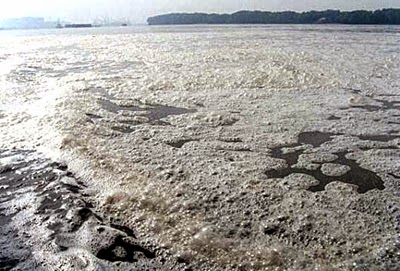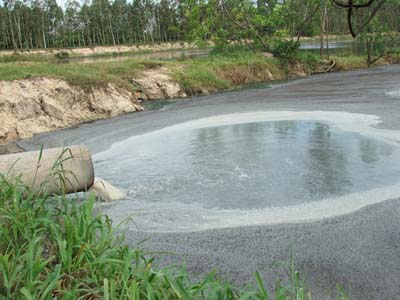WASTEWATER AND WASTEWATER TREATMENT PROCESS
Under the pace of industrial development, urbanization and population growth, water resources in the territories are increasingly under pressure. As a consequence, the water environment in many cities, industrial zones and craft villages is increasingly polluted by wastewater, waste gas and solid waste. Water pollution from industrial production plays a large part in the overall pollution, in addition to pollution from domestic wastewater.
Typically as in specific industries such as textiles, paper and pulp, wastewater usually has an average pH of 9-11, biochemical oxygen demand (BOD), chemical oxygen demand (COD) up to 700mg/1 and 2,500mg/1, the suspended solids content ... are many times higher than the limit. The wastewater content of these industries contains 84 times of cyanide (CN-) compared to standard level, 4.2 times of H2S, NH3+ content exceeds 84 times compared to permitted standards, thus polluting surface water sources in residential areas, without taking into account the industries that have a greater impact on the environment (such as plating, steel, food and beverages production, ...) and domestic waste water.
Wastewater treatment is a common problem of the whole society in general, of industries in particular. Today, the agencies under the Department of Natural Resources and Environment are strictly implementing methods to maximum prevent the amount of waste produced by the production.

Wastewater treatment process
-
Wastewater from the factories' sources is fed into the receiving tank, with the raw waste filtration equipment placed. The raw sludge is separated from the wastewater.
-
After flowing through the receiving tank, the effluent goes through the grease separating tank (for systems requiring). Wastewater submerse and is pumped into the waste filtration equipment to separate solid waste in small size before self-flowing into the regulating tank. The fine sludge is also separated.
-
The regulating tank is responsible for regulating the flow and concentration of pollutants in the wastewater before entering the rear units. The air blower is supplied to the tank for disturbance to avoid the anaerobic phenomenon.
-
Wastewater from the regulating tank is pumped up the cotton-creation coagulation tank, simultaneously the PAC (coagulant adjutant) and Polymer (adjutant creating deposition cottong) are added to perform the course of coagulant creating cotton: combining and stimulating the combination among colloidal materials in the wastewater to create the larger elements compared to smaller elements which are not handled by raw and fine filtration equipment. The larger elements, after the course of coagulant creating cotton in the wastewater will submerse and waste remove to become mud.
-
Then the wastewater self-flows through the flotation system, where the mixture of air and wastewater is mixed to form fine foam under atmospheric pressure, the air bubbles separate from the water, simultaneously pulling along the floating oil and some suspended dregs. The amount of grease, oil and suspended dregs separated from the effluent by means of an automatic swipe equipment is directed to the slurry tank. Floating tanks incorporate flotation course and coagulation to achieve high removal efficiency. At the same time, the phosphorus removal efficiency of the whole system has also been improved thanks to this work.
-
Wastewater is passed through the anaerobic treatment tank. Highly contaminated wastewater will come into contact with the anaerobic sludge and all of the biochemical processes will take place in the sludge, including hydrolysis, acidification, acetate creation, creation methane gas, and other final products.
-
The effluent after being discharged from the activated sludge tank adheres to the spillway through the settling tank. Here, the course of phase separation submersion and retention of the mud (microorganisms). Mud after submersion is pumping to anaerobic tank and anoxic tank to maintain microbial concentrations in the tank. The excess sludge is pumped into the slurry tank. All of the treated sludge is stored (sludge pressing) and the unit has a collection function.

Chemical treatment in wastewater treatment
Most common wastewater treatment processes use the above steps, depending on the type of wastewater that one or more parts are removed. For other special processes that fall outside of the generality of the procedure above, one or more of the following major processing systems shall also be applied:
-
Mechanical treatment: removing waste, residue, ... through the filter, regulating the flow and concentration of wastewater.
-
Chemical treatment: coagulation - cotton creation - deposition (excluding the process of output sterilization with chlorine).
-
Biological treatment (activated sludge) combines Nitrification (Nitrification and Denitrification): removing organic pollutants in wastewater.
-
Sludge treatment: reduce the moisture content of the sludge prior to disposal according to regulations.
So, in the wastewater treatment system, in addition to the fixed investments for other parts (mechanical, biological, sludge, etc.), the treatment system by chemical is a continuous investment. Because of the peculiarity of chemicals, chemical products are often expensive when relatively compared to the economic benefits of a wastewater treatment system. Therefore, the adding of coagulant chemicals - cotton creation (which plays an important role in the handling of suspended particles smaller than 10-4mm) with accurate flow not only helps to well complete the task of process of small particle deposition, but also save on related costs.

